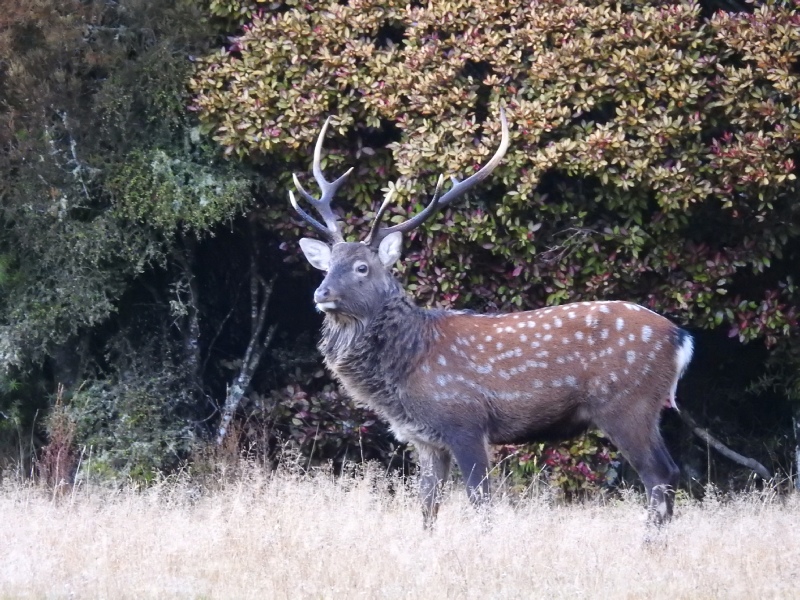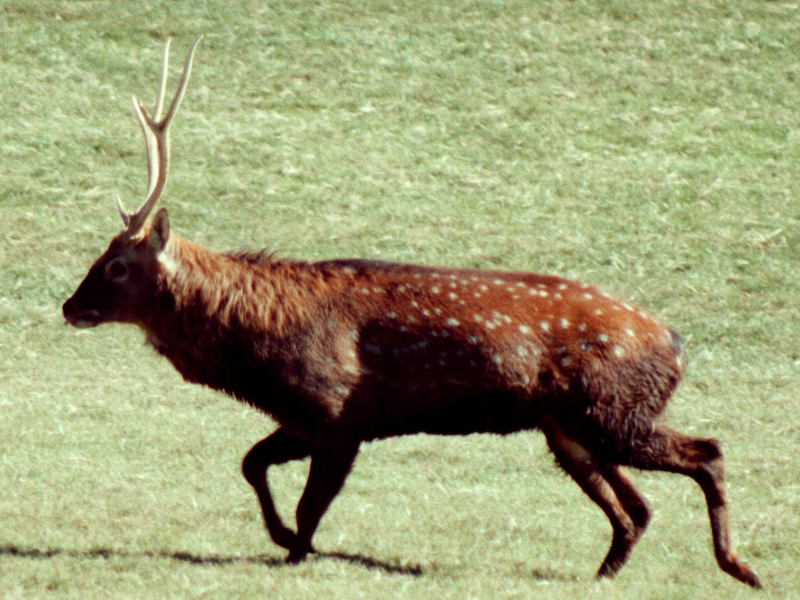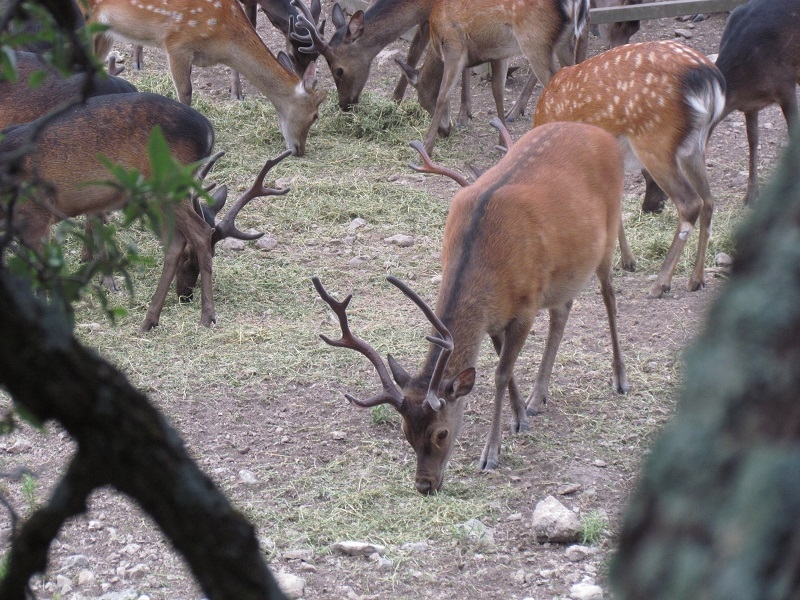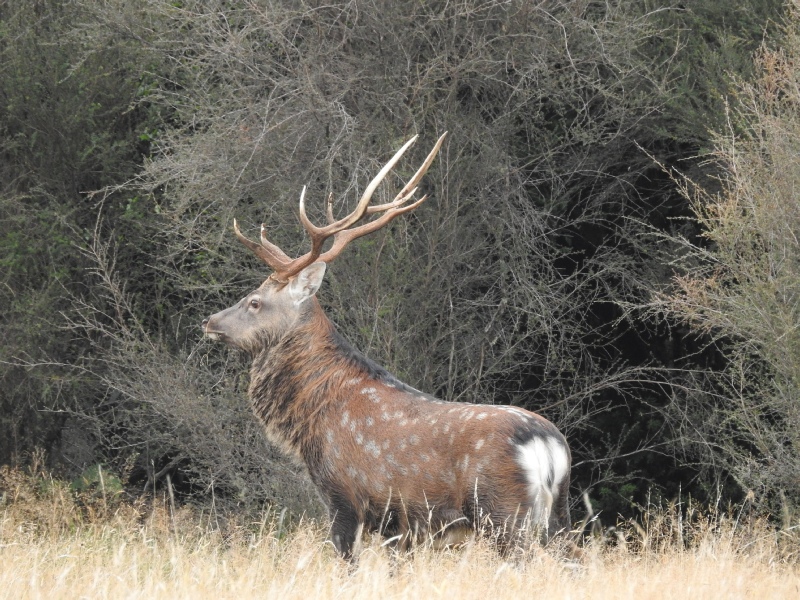Legal Status
- Wildlife Act 1976 / 2000
Key Identification Features
The Japanese sika deer is the smallest of the three deer species now resident in Ireland. Colouration differs during the year depending on the season with a lighter summer coat being white and spotted with an over all dark brown to chestnut brown tint, a dark central strip runs down the back. The autumn moult produces a dark brown to black coat with the male stag developing a shaggy mane on the chest for the rutting season. Each deer has a unique pattern of white spots along its back and flanks which can be used to identify individuals. A white rump patch is present throughout the year as are white hock glands located on the back of the legs which allow for easy identification. The sika deer’s head is more narrow and pointed than fallow or red deer and the stags have an antler design similar to but smaller than the red deer which are in a V-shape usually with four forward facing points. Antlers are shed in the spring with re-growth beginning immediately. The antlers will be covered with a dark skin known as velvet which will be scraped off to reveal new antlers in autumn in time for the mating season. Tracks known as slots are up to 6cm long and are similar to those of red deer and sheep. Mature adult stag’s head and body measure up to 1.5m in length with a short 15cm tail. They stand to 90cm at the shoulder and weigh up to 65kg. Females known as hinds are smaller standing at 70cms to the shoulder and weighing up to 35kg, they are easily distinguished from the males as they do not develop antlers. Sika deer have good eyesight and hearing and a well developed sense of smell. They can sprint quite fast when alarmed but cannot sustain this speed over long distances. They are strong swimmers and can leap over high barriers if being pursued. A hybrid species of sika and red deer has emerged in Ireland as the two species are closely related and have been cross breeding for some time. The hybrid’s rump patch is more prominent as it is not surrounded by any dark hairs. Stag antlers are similar to those of sika stags but are usually longer and more curved. Depending on the parentage a wide variety of types have emerged making some individuals difficult to separate from either sikas or red deer.
Habitat
Sika deer are mainly associated with woodland areas which have open grasslands nearby. They do not show a preference for either coniferous or deciduous woods but will move into an area which has recently been planted with coniferous trees which is an ever increasing habitat type in Ireland due to recent re-forestation drives. They generally avoid open hillside areas or parks that do not provide a cover of thickets. A forested area which provides dense undergrowth of hazel, brambles, blackthorns and rhododendron located on damp soil seems ideal for the sika deer. Once established in an area the home range of an individual will depend on its sex. Females will generally remain in one area which can be as small as 50ha2 as long as it is of good habitat quality where as the male will roam over much larger areas often up to 1000ha.
Food and Feeding Habits
Like all deer species sika deer are strictly vegetarian with this species having a tolerance for poorer nutritional food types as they have the capacity to digest more fibrous material than other deer. Depending on the habitat and seasonal availability they will eat grass, tree leaves, herbs, acorns, fruits, berries, fungi and heavier tree bark material of heather and where available, young coniferous tree saplings. Sika deer can be active both day and night, mainly feeding in the morning and early evening. They are social animals and form groups of separate herds depending on their sex and the time of the year. Hinds will group together with their young while male groups will form as their antlers grow in preparation for the rutting season. When the mating season ends mixed groups will remain together until spring comprising of hinds, their calves and young bachelor males. Mature males are more solitary in nature and spend most of the year alone only retuning to a herd once a year for the mating season. An unusual feature of the Sika deer behavior is the flaring of the white rump patch as an alert signal. The surrounding dark hairs become erect giving a heart shaped white warning flag in times of potential danger.
Reproduction and Life Cycle
The beginning of the mating season is marked by the increased vocalization of the stags. First heard in August males will emit a high pitched whistle which will change to a hoarse scream raising and falling in pitch as the rutting season progresses most likely as a warning to other males in the area. Stags will become more aggressive at this time with frequent fights erupting where antlers are locked and opponents will attempt to wrestle and push each other backwards. Scent markings screted from facial glands will be deposited on vegetation with larger tress becoming scored with antler marks. The mating season runs from August to December with a peak of mating activity occurring in September and October. If a hind mates early in the season but does not become pregnant she will take the opportunity to mate again later in the rutting period. Due to the dominance of mature stags most male deer won’t get a chance to mate until they are at least four years old, with females likely to breed earlier at around one an a half years of age. Different populations of male sika deer will employ one of two main mating strategies. Some stags will attempt to gather together a group of hinds in order to mate with them, in other areas the stag will defend a specific location which will be visited by hinds such areas are known as rutting stands. Once pregnant the gestation period will last for eight months usually producing a single calf but in some cases twins are born. When born in May and June calves are 3kg in weight on average. A survival strategy for deer is to leave the newborn calf hidden in vegetation for a week until it becomes strong enough to move with the herd. This practice was developed in the distant past as a way to avoid predators. Calves are weaned up to eight months and can graze after one month. Parental care is given by the females only. Female calves usually remain in the area in which they were born within a hind herd, with male calves dispersing when they are one years old to join bachelor stag herds. On average sika deer have a lifespan of 15 years in the wild.
Current Distribution
Sika deer are believed to have originated in northeast Asia and Japan one million to 500,000 years ago. There is a long history of husbandry of the species and human influence is the main determining factor in their spread. They are now present in Ireland, England, Scotland, Denmark, France and Germany on the European continent and have also been introduce to New Zealand, Australia and South America. The first Irish population was introduced to the Powerscourt estate in county Wicklow in 1860 then to Kilarney four years later. There are now four main strongholds of sika deer herds in Ireland located in Kilarney national park, county Wicklow, county Tyrone and county Fermanagh. Through a series of escapes and releases they have now spread to twelve counties in the north, east and south of the country and have expanded their range steadily in all areas. They are absent from the west and midlands. The main sika concentrations are now found in Munster with Ulster and Leinster having more of the sika – red deer hybrids. In good quality habitats of young coniferous forests with adjoining grazing areas the population density can reach up to 50 individuals per 100ha. County Wicklow has the highest concentrations of sika – red deer hybrids with a total national population of all sika and sika like deer estimated to be in the region of 25,000 individuals.
Conservation Issues
The 19th century fashion of importing exotic species to an area to improve upon the indigenous flora and fauna was responsible for bringing the sika deer to Ireland. Their arrival here and subsequent cross breeding with the native Irish red deer species has reduced the native deer’s genetic purity in some areas and therefore harmed the indigenous species. The pure sika population in Ireland is of low genetic variation as it originated from a small source of imported individuals. High densities of sika deer can cause damage to newly planted conifers by the feeding practice of barking which is when they strip off the outer bark to gain access to the inner material which is higher in nutrients. Bole scoring which is a unique trait of the species occurs when stags scar tree trunks causing damage in more mature woodlands. Sika deer can also damage agriculture as they trample and eat in cultivated areas of cereals and dig out root crops like carrots and turnips. In Ireland the sika deer have no natural predator to control their population so legal hunting is used as a means to control their numbers. Packs of feral dogs kill some deer each year as the sika is unable to run for long distances to escape. The delicate hooves of the sika were not designed for travel over rough or snow covered terrain so they will remain confined to lowland areas in Ireland. They are protected under the Wildlife Act in the republic and under the 1985 Wildlife Order in Ulster although they are listed as a quarry species and can be hunted under license which has been and will continue to be the main method of population control in Ireland.



